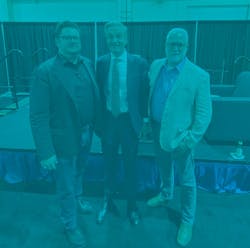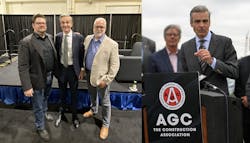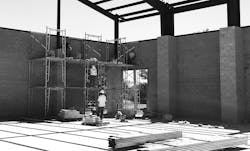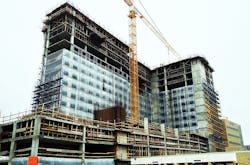Architecture and skilled craft go hand in hand, but you may not be aware that the number of skilled individuals that are required to bring an architect’s ideas to reality. In today’s episode, Andrew and I are talking about the state of skilled labor in the construction industry. This is not a subject that receives a ton of attention, but one that can have a big impact on the work of an architect. Currently, there is a major shortage of skilled workers in the construction industry, and without concerted efforts on many fronts this shortage will continue to grow.
We have a special guest with us today to talk about this issue. Brian Turmail is the VP of Public Affairs and Strategic Initiatives for the Associated General Contractors of America or AGC for short. Brian has been with AGC since 2008 and his main role is to oversee all public relations efforts and communications for the organization and its members. He oversees the AGC’s trade magazine and several programs within the organization that focus on members and charitable outreach.
State of Skilled Labor
According to the Department of Labor, the US economy had 7.6 million unfilled jobs, but only 6.5 million people were looking for work as of January.
The construction industry comprises three sub-sectors: specialty trade contractors, construction of buildings, and heavy and civil engineering construction. Employment in all these sub-sectors is projected to grow over the 2016–26 decade, with more than half (485,600) of the new jobs overall expected in specialty trade contractors.
Specialty trade contractors are the largest construction sub-sector, with employment projected to reach nearly 4.8 million by 2026. Workers in this sub-sector usually focus on a particular activity, such as plumbing, roofing, electricians, sheet metal workers, brick masons, tile and marble setters, and HVAC installers.
Employment in the construction of buildings is projected to be about 1.7 million in 2026. This sub-sector includes general contractors and other establishments that have primary responsibility for an entire building or remodeling project – such as carpenters, construction laborers, construction managers, cost estimators, cement masons, painters, drywall and ceiling tile installers, and structural iron and steelworkers.
The Issue of Knowledge Economy vs labor Economy [3:57 mark]
At some point in the post World War II era, our society in the U.S. as a whole decided we wanted to make the move towards a knowledge-based economic mindset. The country as a whole began to think that additional education and higher education was the best way to improve our country’s economy. Also, there was this prevalent idea among parents in the baby boomer generation of wanting their children to have “more” and increase their economic and social “standing” to a level above the parents. Essentially this was an extension or modification of the American dream; a redefining of that dream based on a model of advanced education.
Unknowingly this had a large impact on the trades which only began to reveal itself in the 1980s and 1990s. Now it has become an extreme issue in the available labor force for skilled trades. The idea that someone can make a living working in the construction trades industry is not typically an option being presented to high school students. The concept of construction and trade work being a career path for intelligent, skilled students to make a good living is not on many, if anyone’s, agenda to present to young people. But for numerous people in the country, this could be a sound and profitable option for a career path. This topic could be discussed for 3 hours on its own, but it is a subject that needs some attention to help in filling this skilled labor gap, and those like Brian within the industry are working on just this issue.
“We are educating a lot of in debt baristas” [25:41 mark]
The market for construction industry workers is on track to continue to grow over the next decade for certain. As this need grows, it is possible that the lack of skilled workers will continue to grow also. This again goes back to the idea of putting young persons on this path and presenting it as an option to live a good life. The average age of the construction worker in the U.S. is 48 years old. This means that in the near future of the industry there will be a large fall-out in the number of experienced skilled trade workers when these folks retire. At the moment, there is a scramble to allow these experienced workers to convey and pass along their knowledge to the younger demographics. So in attempts to create a solution the industry has to look to the long game to resolve the current issues while also attempting to plan for the future.
At the moment, this is a long term battle and those working to “fix” it are aware. But in recent years there has been some growth in trade school enrollment and this is a positive direction towards filling the labor gap. So the work to resolve the issue is starting to take place. This is a complicated issue with many moving parts, but the construction industry is attempting to put programs in place that can start to fill the gap. As Brian points out, there is also an interesting dynamic in the construction industry that as a society, Americans do not really want to work in the construction industry, but we also do not want any immigrants or non-citizens to work in that industry either. So all politics aside, we need to build up the pipeline that gets persons into this workforce. The labor shortages could really be an issue if left unaddressed or addressed improperly.
So How Does this Impact Architecture? [30:24 mark]
While our guest, Brian, has some interesting perspectives on that and I am not certain that I agree with all of them, but it is still a perspective from someone deeply ingrained in the construction industry. Adaptive technologies may make it possible for contractors to get work done with fewer workers if the labor shortage continues to be an issue. Also, some of his points about pre-fabrication may begin to ring true and increase as an integral part of the architectural process due to the increases in technology and as a way to control material consumption.
As far as I can attest to my daily experiences in the past several years, the labor shortage does have an impact on my design process based on the project type and the project location. I know that on some of my more remote/rural projects (especially in education markets), the notion of available labor must be taken into consideration from the beginning phases of design. “Oh, there is not a skilled vertical concrete contractor located within 200 miles”… well, that has an impact on the budget and therefore the design of this project if I want it to be a successful project, meet the client’s needs and be within the budget.
At times, I have to personally know this information or I will rely on construction team involvement early in the process to inform me of this condition. Also, from my perspective, the labor shortage makes it necessary for me to spend more time on the job site if I want my projects to be constructed in the way I intended. This is not to say that I am the construction leader by any means, but that I can attempt to help educate the construction team on the goals and ideas that I have for the project. Then we can coordinate how all of us can best make those come to fruition with the labor force available on the project. At times this amounts to hand-holding (in both directions), and at other times it becomes a modification of the design to meet the available skill. And lastly it can become a bit more confrontational, but I try to never let it get to that condition.
The Perception of the Career Path [41:04 mark]
We need to change the perception of the construction industry workforce and the opportunities it contains for young people entering the workforce in general. We cannot ignore the compensation portion of this path but there are also several other reasons to pursue this path as a young person. Brian discusses some notions about the compensation issues, but also some of the notions about ownership, teamwork, and non-desk oriented work. This industry is changing and adopting new technology daily and this will continue to happen, so these are not solely labor-intensive jobs but they require intelligence, skill, and craft. The increase in the implemented of technology into the construction industry will only increase the requirements for that labor force. These aspects of these careers will most likely only continue to grow in the coming decade and beyond.
Hypothetical [43:20 mark]
Unfortunately, our guest today, Brian Turmail from AGC, had a hard stop when we were recording this episode so Andrew and I recorded today’s hypothetical question after the show from the comforts of my hotel room. Exaggerations, bold-face lies, little lies … is there a difference? Andrew and I get into it with this episode’s hypothetical question.
"Would you rather be able to detect any lie you hear, or get away with any lie you tell?"
Andrew and I got to the obvious answer rather quickly but with just a little discussion, things erode and the obvious answer might not be so obvious. I almost always add a twist to these hypothetical questions so that it forces the person answering the reevaluate their response.
While this might not be the most glamorous topic of discussion and many of our listeners may not “dig” this as a topic, it has the possibility to greatly change our profession moving forward. This issue is complex and involves many moving parts that are only now beginning to be addressed an explored. On top of all those the speed at which technology is changing the construction and skilled trades industry is altering the types of individuals needed to work within this industry. In the end, this labor shortage can impact everyone in the AEC industry and if it continues it will most definitely reshape the way we practice and do our jobs as architects.
We want to again thank Brian Turmail for joining us at the event and taking the time to enlighten us on the topic. Also, many thanks to CONSTRUCT for their support of today’s episode. For more information, please visit CONSTRUCT 2020.







